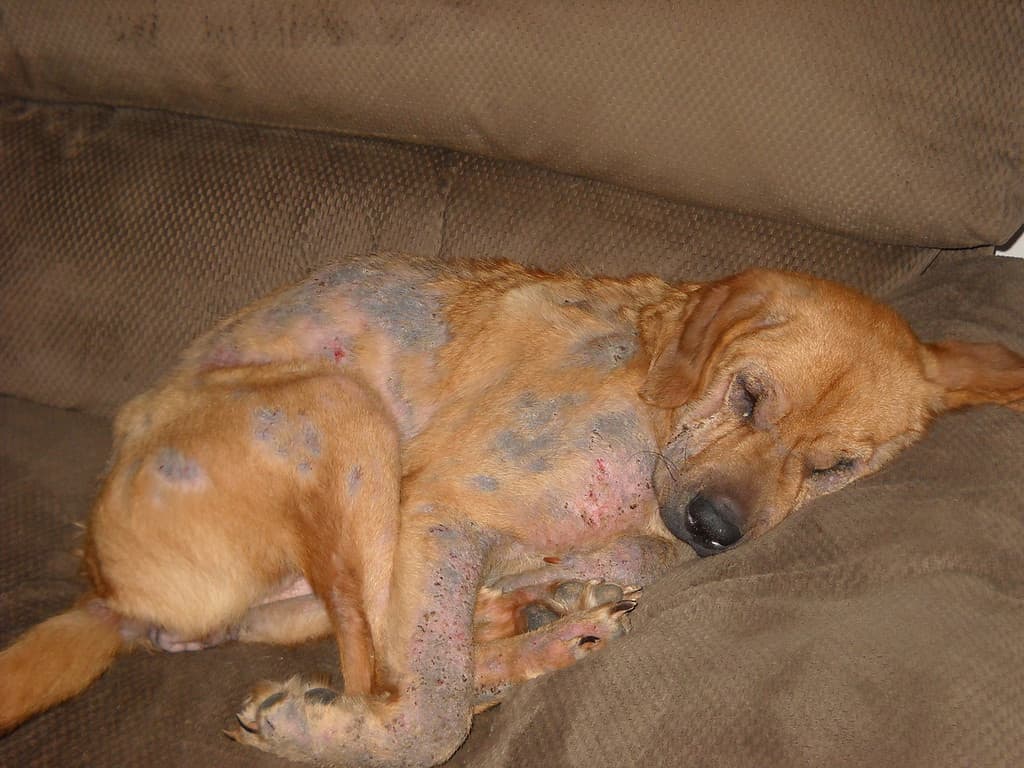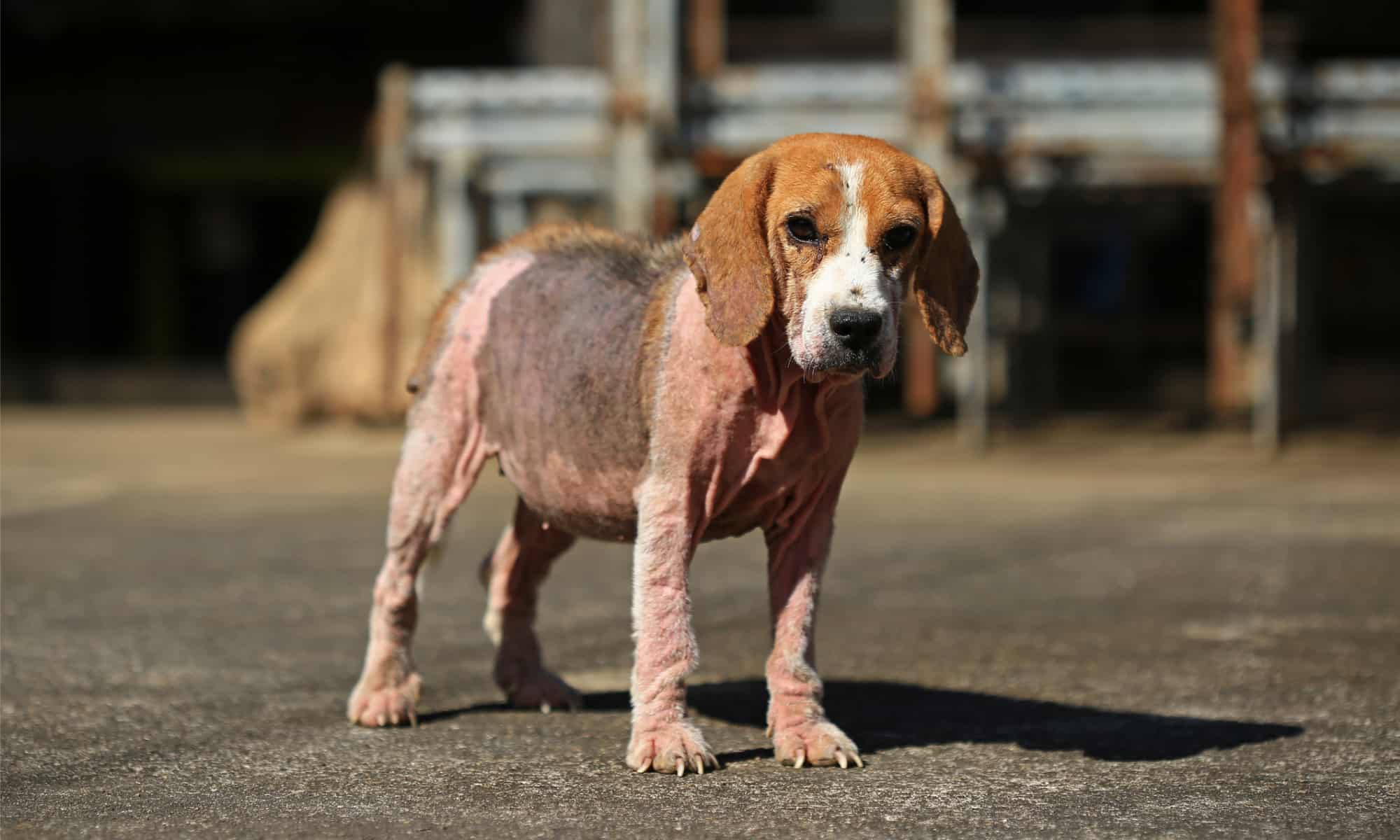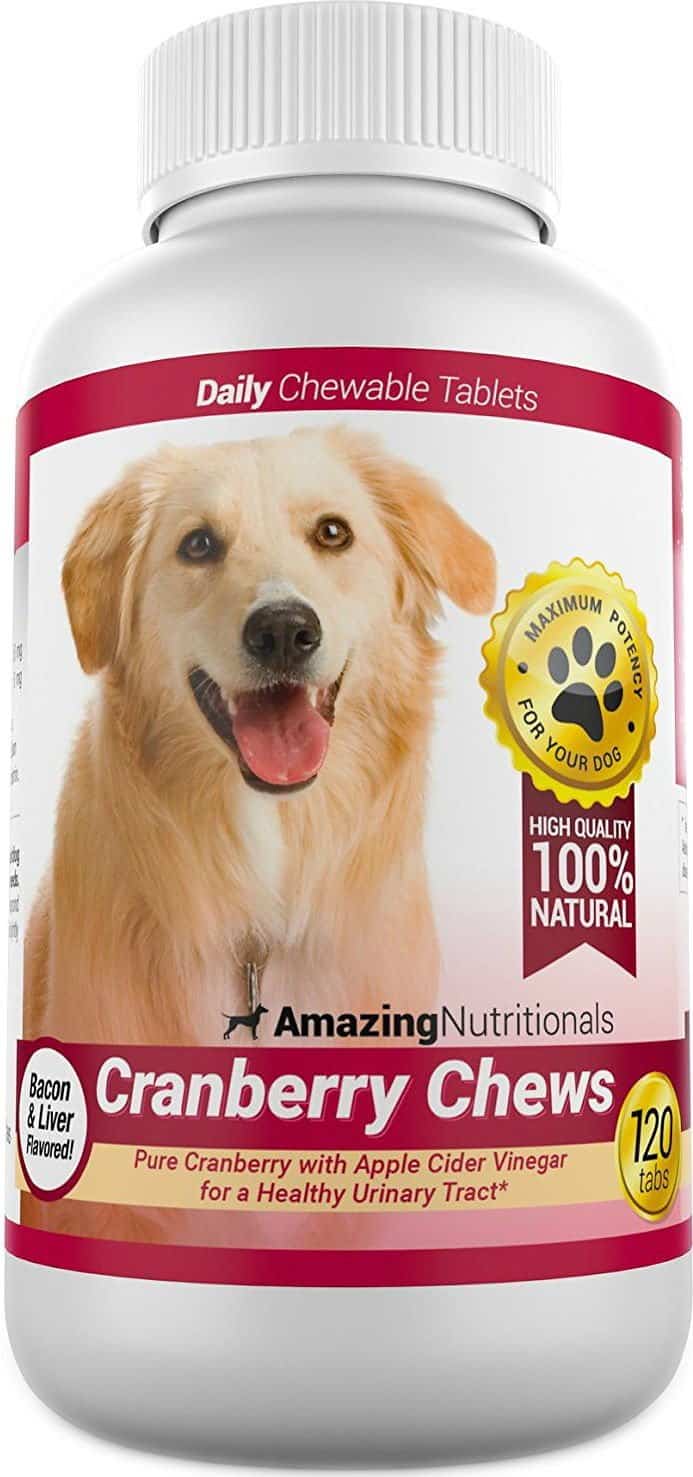Have you noticed that your dog is scratching like crazy and patches of their fur are coming out! There are several possible explanations for this but the one that sounds most unpleasant is – mange. So, how do dogs get mange in the first place?
Dogs get mange from wildlife (especially foxes), other dogs, and infested bedding and grooming equipment. It spreads quickly when there are a lot of dogs in one place like in shelters or kennels. Mange needs to be treated by a vet but you can help your dog heal by giving them immune-boosting nutrients.
What Is Mange?
Mange is a skin condition in dogs. It is caused by tiny little creatures called mites – they are closely related to the ticks that live in long grass. There are actually two types of mites that cause mange in dogs and they cause different types of disease. They are also spread in different ways.
Sarcoptic Mites
The first is Sarcoptes scabiei var canis, the sarcoptic mite. It has an oval tortoise-like body that measures just 0.30-0.45 mm long by 0.25-0.35 mm wide and has short, stubby legs. You need a microscope to see it and it burrows into the skin where it lives just under the surface.
It causes sarcoptic mange although this type of mange can also be caused by another mite called Notoedres. The common name for this type of mange is scabies and other animals, including humans) can also get it.
Demodectic Mites
The second is Demodex canis, the demodectic mite which causes demodectic mange. You may also see it called Demodex or red mange. It has a cigar-shaped body that measures just 280 micrometers in length so it is invisible to the human eye without the help of a microscope.
Demodectic mites live in hair follicles and can also be found on other animals including humans.
- Perfect for dogs resistant to taking pills.
- Feature healthy ingredients like MSM and fish oil, in addition to cranberry and apple cider vinegar.
How Do Dogs Get Mange?
Dogs can get mange in a number of different ways depending on which type of mite is causing the problem. Let’s look at the sarcoptic mite first.
The mites live in burrows just under the surface of the skin where the females lay their eggs. They hatch to produce larvae which cut through the skin to make new burrows. The larvae molt to become nymphs which grow into adults. The life cycle takes about three weeks.
These mites prefer to live on animals in the dog family so which includes foxes, wolves, coyotes, and, of course, domestic dogs. It is spread from one dog to another very easily and is therefore described as highly contagious.
How do dogs get mange, or sarcoptic mange, to be exact? Here are 5 ways.
1. Wildlife
Mange caused by sarcoptic mites is highly contagious and can spread from wildlife to domestic dogs. Therefore, your dog can get it from foxes and coyotes. You may not even realize that foxes are entering your yard and bringing the mite with them. This type of mange is sometimes called ‘fox mange’ for this very reason.
2. Other Dogs
Does your dog like to roll around play-fighting with other dogs in the dog park? This type of close contact is ideal for the mite to travel from one dog to another. They get rubbed off the skin of one dog and land on another. Soon, they have burrowed into the skin and their life cycle starts again.
3. Bedding and Blankets
Sarcoptic mites can live outside a dog’s body for several weeks. This means that they can live in bedding and blankets. If an infested dog uses a bed or blanket, the mites will rub off and end up on the fabric. Then when another dog goes into the bed, the mites will get onto the new dog and set up a new infestation.
4. Rescue Shelters and Kennels
Any location that has a lot of dogs is more likely to have sarcoptic mites living in the environment. Therefore, this condition is often associated with dog shelters and kennels. If mange is diagnosed in an animal shelter, the affected dog will be immediately treated and separated from the other dogs.
5. Groomers
Most groomers are trained to spot mange in dogs and will, quite rightly, refuse to groom a dog that has mange. It is very irresponsible to take a dog that you know has mange to a groomer because it is so contagious. Both other dogs and the groomer themselves can get it. At the groomer, the mites can live on towels, clippers, leashes, and brushes that are not completely disinfected in between doggy clients.
How Do Dogs Get Demodectic Mange?
The spread of demodectic mange is completely different from sarcoptic mange. It is not contagious so if your dog has this type of mange it did not get it from another dog.
Demodectic mites enter a puppy’s hair follicles and oil glands on the skin from birth and will stay there throughout a dog’s life.
Most of the time, a dog’s immune system will keep them in check. However, some dogs have immune systems that are not functioning so well. This happens in pups under 18 months of age (because their immune system is still not mature) and in adult dogs that have health conditions (like diabetes or cancer) that affect the immune system. Some medications cause the same issues. Also, senior dogs tend to get this type of mange more often because their immune function declines as they get older.
•Formulated for senior dogs
•Glucosamine and chondroitin for joint health
•Antioxidants for immune support
•Natural, wholesome ingredients
Symptoms of Sarcoptic Mange
The symptoms of sarcoptic mange do not show up straight away. It can be anything between 10 days and 8 weeks before a dog will show any symptoms. Itching around the ear flaps and elbows is usually the first sign. The chest, hocks and belly are also affected. As well as extreme itching, you may also notice the following:
- Skin appears red and inflamed
- Open sores
- Thick yellow crusts on the skin
- Bald patches where hair has come out
- Skin infections where the skin has been damaged by scratching
In advanced cases, you may also see a thickening of the skin, enlarged lymph nodes, and weight loss. Sadly, this can lead to death in extreme cases.
Any dog with these symptoms needs to be seen by a vet right away. Your vet can diagnose sarcoptic mange by taking a scraping of the skin and examining it under a microscope to look for mites or their eggs.
Symptoms of Demodectic Mange
Unlike sarcoptic mange, demodectic mange does not usually cause itching. It does, however, cause hair loss and this appears as patches. It usually starts on the face, especially around the eyes. Where the skin is exposed, it looks red and scaly. If the hair loss is limited to small areas of skin, it is called localized demodectic mange.
If large areas of skin are affected, it is called generalized demodectic mange and dogs can end up losing most of their hair. Their skin will be very scaly, inflamed and will look crusty.
Dogs with hair loss need to be seen by a vet who will take scrapings from the skin and look for mites.
- Made with oatmeal
- Contains antibacterial and anti-fungal ingredients
- Shampoo and conditioner in one
- Veterinarian endorsed
Treatment for Mange
Mange needs to be treated by a vet. They will generally use an isoxazoline medication that is also found in many flea and tick control products. It is usually taken orally (your dog has to swallow it) and the itching eases in a few days. Other dogs are treated by weekly dipping in scabicidal shampoo for up to six weeks. Some treatments such as selamectin and imidacloprid-moxidectin formulations are applied to the skin directly. The mange mite can develop resistance to medications so your vet may need to try a few approaches before finding one that works.
To give some instant relief from the intense itching, your vet may also prescribe steroids and your dog may need antibiotics if their skin has become infected. They may also have their hair clipped.
While they are being treated, your dog needs to be kept away from other dogs. You will need to wear gloves when you are handling them and wash your hands thoroughly in soap and water. All household fabrics that your dog has come into contact with will also need to be washed.
•Easily digestible kibbles
•Prebiotics, vitamin E, omega fatty acids
•Promotes nutrient absorption
•Balances gut biome
How to Help a Dog With Mange Heal
It’s your job to keep your dog as comfortable as you can while they heal from mange. It can be a stressful time for dogs and unfortunately, the stress can affect their immune system which makes things worse.
Discuss what you can do to help your dog heal with your vet first. They may recommend some immune support products or soothing shampoos. It’s also important that your dog has a high-quality diet at this time to support their immune system and to provide nutrients such as Omega-6 fatty acids and vitamin E to specifically support their skin and coat.
Bonus: Are Some Breeds Susceptible to Demodectic Mange?

Demodectic mange causes hair loss, itching and crusting of the dog’s skin.
A study in the UK found that some dog breeds seem to be more susceptible to demodicosis – which occurs when the mites in hair follicles multiply to excessive numbers. According to their findings, seven breeds showed an increased risk of juvenile-onset demodicosis: British bulldog, Staffordshire bull terrier, Chinese shar-pei, Dogue de Bordeaux, pug, French bulldog, and boxer.
Six breeds showed a reduced risk of juvenile-onset demodicosis: Lhasa apso, bichon frise, Labrador retriever, German Shepard, shih-tzu, and chihuahua.
Ready to discover the top 10 cutest dog breeds in the entire world?
How about the fastest dogs, the largest dogs and those that are -- quite frankly -- just the kindest dogs on the planet? Each day, AZ Animals sends out lists just like this to our thousands of email subscribers. And the best part? It's FREE. Join today by entering your email below.
Thank you for reading! Have some feedback for us? Contact the AZ Animals editorial team.












